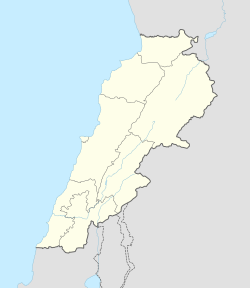Ouyoun
This document addresses the topic of Ouyoun from different perspectives with the aim of providing a comprehensive and complete vision of this topic of interest. Its historical aspects, its current implications, as well as possible future scenarios are analyzed. Through a multidisciplinary approach, the different angles from which Ouyoun has impacted or can impact in various contexts are explored. Likewise, various expert opinions are presented and a critical reflection is offered on the implications and challenges that Ouyoun poses for society as a whole. This article aims to contribute to the analysis and informed debate about Ouyoun, providing elements that enrich the understanding and dialogue around this topic.
Ouyoun
العيون | |
|---|---|
City | |
| Coordinates: 33°52′58″N 35°39′12″E / 33.88278°N 35.65333°E | |
| Country | |
| Governorate | Mount Lebanon Governorate |
| District | Matn District |
| Government | |
| • Time Zone | GMT +2 (UTC) |
| • - Summer (DST) | +3 (UTC) |
| • Area Code(s) | (+961) 4 |
| Area | |
• Total | 10 km2 (4 sq mi) |
| Time zone | UTC+2 (EET) |
| • Summer (DST) | UTC+3 (EEST) |
| Dialing code | +961 |

Ouyoun (Arabic: العيون translit. al-ʿouyoun) is a village in Mount Lebanon, Lebanon.
Overview
Ouyoun or Aiyoun is a village in Mount Lebanon. It is mostly known for its rolling verdant hills, pine forest trees, water springs, that are vibrant with depth, movement and colors. Its Saint Joseph church inspires reverence and contemplation.
Etymology
The name 'Ouyoun' means springs in Arabic. The name is given because of the many water springs that are there.
Geography
Ouyoun is located east of Broumana. Area is about 10 km2. It is located 800 meters(2624 feet) above sea level and 10 miles (16 km) east of Beirut.
Ouyoun's inhabitants are mainly from the Abou Diwan family, with many inhabitants also from the Chakhtoura family.
Demographics
The demographics of Ouyoun are all followers of the Christian faith with majority being the Maronite and Syriac Catholic with minorities being Greek Catholic and Greek Orthodox.
References and footnotes
External links
- Aayoun, localiban

